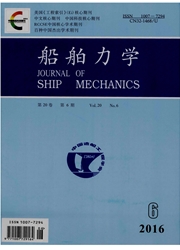

 中文摘要:
中文摘要:
TLP立管系统以丛式方阵排列,台风条件下立管在波浪、海流及平台的联合作用下可能发生碰撞,有必要深入研究TLP串行立管系统的碰撞情况。文章基于DNV-RP-F203规范和Huse半经验尾流模型,提出台风条件下串行立管下游立管来流速度计算方法和立管系统碰撞分析方法,建立串行立管—井口—导管系统耦合有限元模型,研究台风条件下串行生产立管系统碰撞时的力学特性,在整体碰撞分析的基础上进行立管局部碰撞精细化分析,对比分析立管局部碰撞理论解和仿真解的不同。结果表明:下游立管来流速度的计算至少采用文中建立的方法迭代3次。串行立管发生碰撞时的最大应力发生在泥面导管处,碰撞位置应力发生了突变;立管发生碰撞的位置在水深100-120 m范围内。立管局部碰撞分析的理论解和仿真解基本吻合。
 英文摘要:
英文摘要:
The collision between risers in tandem may occur with the combined effects of current, wave and platform motion since the tension leg platform riser system are arranged in clusters. It is necessary to further study the collision of TLP risers in tandem. The calculation method of flow velocity of downstream riser and collision analysis method of riser were determined based on DNV-RP -F203 and Huse semi -empirical wake model. Then Coupling model of riser-conductor-wellhead in tandem was established to study the me-chanical properties of them under typhoon. The fine analysis of the local collision risers was made based on the analysis mentioned above. The difference between the theoretical solution and the simulation solution of the local collision of riser was studied. The results showed that the calculation of flow velocity of downstream riser was at least 3 times. The maximum stress of collision risers located at the mud conductor and the stress of collision location was suddenly changed. The location of risers collision occurs at the water depth ranging from 100 m to 120 m. The theoretical results and simulation results of local collision fit good.
 同期刊论文项目
同期刊论文项目
 同项目期刊论文
同项目期刊论文
 期刊信息
期刊信息
